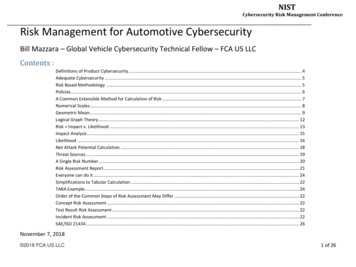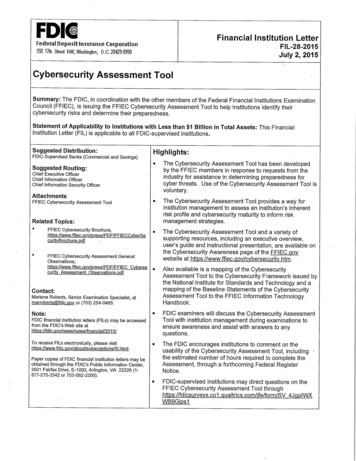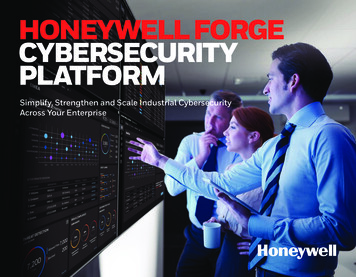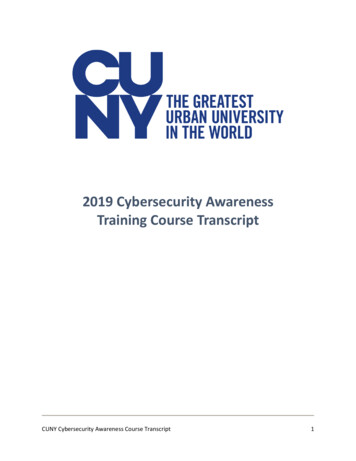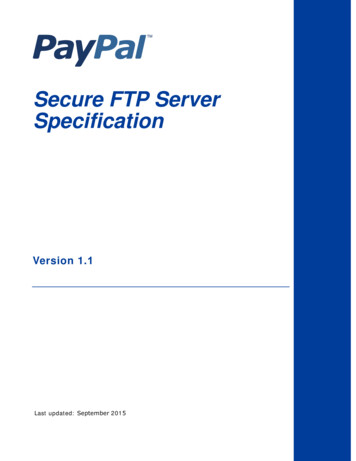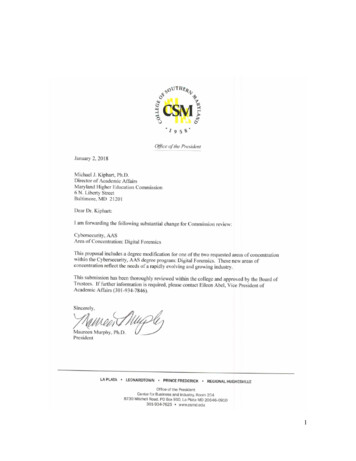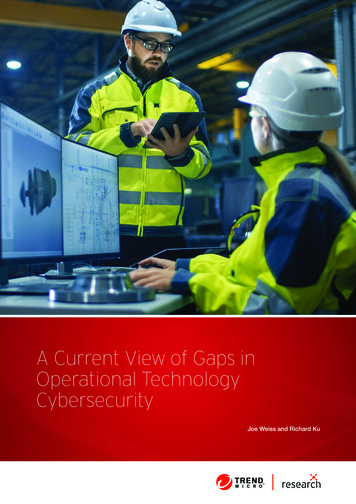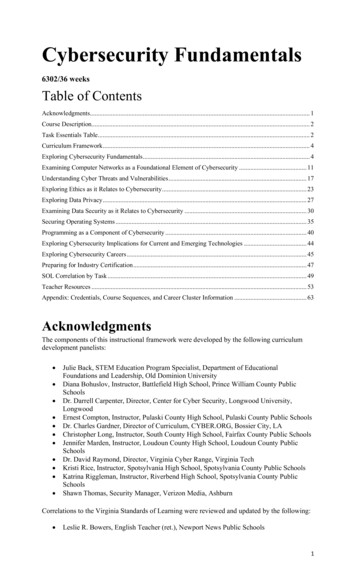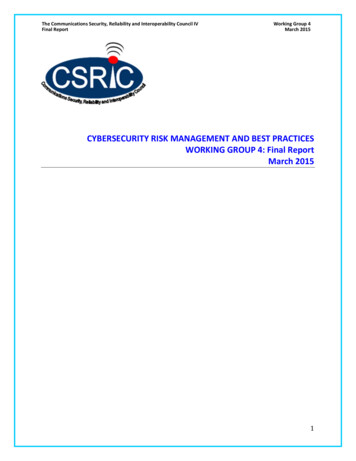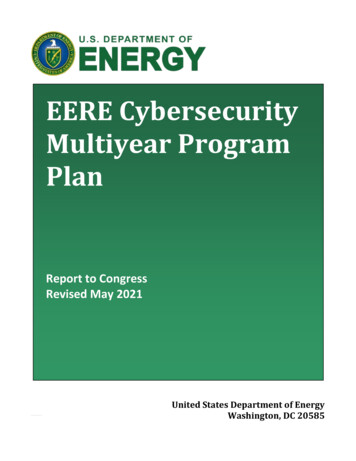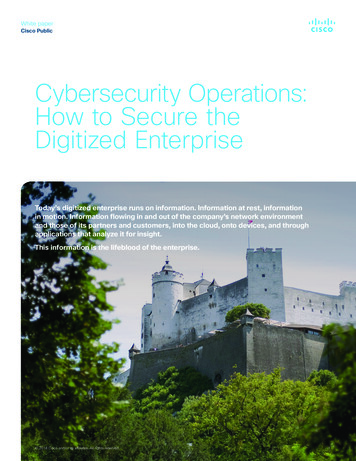
Transcription
White paperCisco PublicCybersecurity Operations:How to Secure theDigitized EnterpriseToday’s digitized enterprise runs on information. Information at rest, informationin motion. Information flowing in and out of the company’s network environmentand those of its partners and customers, into the cloud, onto devices, and throughapplications that analyze it for insight.This information is the lifeblood of the enterprise. 2018 Cisco and/or its affiliates. All rights reserved.1
White paperCisco PublicWe live in a worldwhere change is aconstant and thespeed of changeis accelerating.Companies thatcan leverage digitaltechnologies toaccommodate rapidchange succeed.Organizations that can’tevolve will fall behind.Whether information is stored or on the move, it has become a prime targetfor those with malicious intent. As the threat landscape expands, the needfor new skills to address vulnerabilities, respond to breaches, and reducerisk is all-important.In response, IT departments have set up security operations centers (SOCs),staffed by professionals with a variety of skills and experience. One ofthe central roles in SOCs is played by security analysts. They monitor ITsecurity systems. They detect and address cyberattacks, insider threats,vulnerabilities, and honest errors. They gather and analyze evidence. Theycompare, categorize, and correlate information. They direct the center’sresponses to a wide variety of cybersecurity events.To be successful, SOCs need experts. For these experts to be successful,they need skills. And we can help.This white paper outlines the trends in digitization that make it critical tohave SOCs staffed with cybersecurity operations experts. It describes theskills needed for cybersecurity success. It also details Cisco’s training andcertifications for the critical security analyst role. Specific topics coveredinclude these: How good cybersecurity practices enable enterprises to protect themselvesand foster trust SOCs as cornerstones of good cybersecurity programs The disturbing state of enterprise cybersecurity event preparedness The severe shortage of skilled cybersecurity professionals New levels of skill required for securing digital enterprises A day in the life of a cybersecurity professional Cisco’s expansion of security certifications to help close the skills gapBenefits of good cybersecurity practicesWe live in a world where change is a constant and the speed of change isaccelerating. Companies that can leverage digital technologies to accommodaterapid change succeed. Organizations that can’t evolve will fall behind.Going digital affects all parts of the organization. Back-office processes,interactions with employees, customers, partners, everything. And the rateof digital adoption is growing.According to a recent Harvard Business Review survey of 150 large U.S.companies, digitization makes a big difference.1 Researchers found that“digital leaders” outperform competitors by roughly 10 percent, with thegap between leaders and laggards getting larger. 2018 Cisco and/or its affiliates. All rights reserved.1. Manyika, James, et al., Harvard Business Review, “The Most Digital Companies Are Leaving All the RestBehind,” January 2016.2
White paperCisco PublicAll digital economystakeholders need toconsider how linkedassets and processesmake a new level oftrust necessary.Digitization is bringing change that is as much revolution as evolution.Mobility, big data, the cloud, collaboration, and the Internet of Things(IoT) are coming together. They are profoundly shifting how organizationsoperate, how markets are being disrupted, and how countries are growingtheir economies.According to the Cisco Global Cloud Index: Forecast and Methodology,2015-2020, for every single piece of information created or entered by aperson, there will be 277 pieces of information automatically created bya machine. Information will be formed at a rate far greater than previouslypossible, and in much greater volumes. Information created by machines isshared far and wide by networks that connect millions of people, devices,and sensors.Automated analytics takes that far-flung information and wrings freshinsights from it. The fact that the network is the platform for sharing andanalyzing this information makes securing it increasingly important.That need—to keep expanding networks secure—merits special attention.Digitization is now the way that enterprises operate, grow, and succeed.But digitization also gives bad actors many more ways to disrupt operationsand damage trust. The risks and rewards are huge for all. This makescybersecurity operations a major, if not the dominant, part of overallenterprise risk management.All digital economy stakeholders need to consider how linked assets andprocesses make a new level of trust necessary.The need for trusted transactions across the Internet was created withthe advent of e-commerce. Now, trust needs to be embedded in all of thepieces of a digital organization and along the entire chain of transactions,including people, machines, networks, sensors, analytics, applications,information, and controls.Without trust, a digital organization cannot survive. Efforts to create andensure trust should be comprehensive in scale and scope.Everyone needs to be able to trust the systems that manage and processinformation. They must also be able to trust the people who access, create,and use information. And the systems and controls, and the fundamentaltechnologies and processes that protect that information.We intuitively know the value of trust. But trust is hard to create, easilybroken, and difficult to restore once it is broken.The impact of broken trust is also magnified in today’s high-speeddigital economies. Millions of customer records, or an organization’sintellectual property, or even critical resources can be compromised withunprecedented speed and stealth. 2018 Cisco and/or its affiliates. All rights reserved.3
White paperCisco PublicEnsuring trust is whySOCs are necessities.This is true whetherthe SOC is internalor is provided bya third party, suchas a managedsecurity serviceprovider (MSSP).Digital technologies provide companies and countries with ongoing advantages.Yet for long-term success, security and trust must be embedded in all parts ofthe digitized organization, and they must be end-to-end. Trust must becomepart of enterprise DNA.SOCs as cornerstones of goodcybersecurity programsEnsuring trust is why SOCs are necessities. This is true whether the SOC isinternal or is provided by a third party, such as a managed security serviceprovider (MSSP).A SOC directs rapid detection and response to cyberthreats around theclock. The SOC is charged with monitoring and protecting many assets. Suchas websites. Applications. Databases. Data centers and servers. Networks.Desktops. Other endpoints, such as mobile devices, and IoT entities, includingthe connected controls found in networked industrial equipment. The SOCassumes overall responsibility for monitoring, assessing, and defending all ofthese assets against cyberattacks.A SOC team has many roles. While SOC teams vary, these rolestypically include the following: Cybersecurity analyst—analyzes information from cyberdefense toolsto assess events and mitigate threats Incident responder—investigates, analyzes, and responds to incidents Forensic specialist—identifies, collects, examines, and preservesevidence using analytical and investigative techniques Cybersecurity auditor—performs cybersecurity assessments ofsystems and networks, measures the effectiveness of the cybersecurityarchitecture against known vulnerabilities, and assesses compliancewith regulatory requirements Cybersecurity SOC manager—manages the SOC personnel, budget,technology, and programs and interfaces with executive-levelmanagement, IT management, and the rest of the organizationThree trends have led to the rise of SOCs.First is the need for centralization. A centralized real-time view of alldigital assets and processes makes it possible to detect and fix problemswhenever and wherever they occur. Centralization is crucial for IoT systems.The sheer numbers of devices and the likelihood that they are widelydispersed make local monitoring impractical.Second is the need for an environment where skilled people with the righttools can react quickly and collaborate to remediate both system-wide andlocal problems. 2018 Cisco and/or its affiliates. All rights reserved.4
White paperCisco PublicThe good news?Cybersecurityoperations canprovide benefits thatcan be measured.Third is the need to blend cybersecurity tools and people who are skilledin using them with other critical IT functions and business operations.They must align with business objectives and compliance needs for ahigh-performing operation that is efficient and effective.A dialog between the SOC and the rest of the enterprise has to be partof overall corporate risk management efforts. Cybersecurity and physicalsecurity must have strong voices at the table.Technology readiness is important. But even as artificial intelligenceassumes a larger role in enterprise operations, people still count. Havingthe right people to protect information will count the most.Problematic enterprise preparednessBad actors are getting smarter and moving faster in stealing digital assetsand processes, and they are doing it more often. The results have sometimesbeen devastating, and the problem will only get worse. A recent Forbes.comarticle predicts that cybercrime costs will reach US 2 trillion by 2019, upfrom 450 billion in 2016.2The good news? Cybersecurity operations can provide benefits that canbe measured. In addition, spending on protection against cyberthreats,in specific solutions and SOCs, is going up. Still, studies show thatinvestments in protection and people are not keeping pace with therising risk profile of digitized organizations.There are several reasons for this problem:1. The rising complexity of the security landscape—The typical enterprisehas 30 to 40 different security vendor products in its network. Securityteams generally are not 100 percent sure how these devices, solutions,and services work with one another. They also don’t know whether thereis overlap or, worse, gaps in protection. Or how much work needs to bedone to integrate and correlate information coming in from different tools.2. The changing nature of cyberattacks—There are new threats daily. Theseattacks are coming not just from individuals, but are increasingly led bywell-funded organizations, including rogue groups and government-backedsources. The commercialization of hacking is resulting in exploits that aremore frequent, better financed, more sophisticated, and more damaging.Even just a partial list of damage is sobering: Espionage, including commercial, nation-state, and financial Damage to brand or reputation Damage to systems Ransom demands2. Morgan, Steve; Forbes.com, “Cyber Crime Costs Projected to Reach 2 Trillion by 2019,” January 2016. 2018 Cisco and/or its affiliates. All rights reserved.5
White paperCisco PublicThe skills shortageis the biggestcybersecuritychallenge theindustry is facing. Fraud and identity theft Attacks on customers made by pivoting through the enterprise Stolen customer information and breaches of privacy Exploitation and takeover of network-attached resources Stolen intellectual property Theft of online resources or access credentials Gaming of stock prices3. The IoT—It has created a wealth of new opportunities. But the risingnumber of connected devices provides cybercriminals with new andunforeseen ways to gain access to systems and information. In addition,end-to-end security is not part of legacy IoT systems.4. Cybersecurity risk is more than just outright attacks—Digitalorganizations need to have a systemic way of evaluating attack risks.As all aspects of IT become more complex, new risks are brought tothe table. Lost laptops or phones can result in substantial informationbreaches, for instance. Another set of issues for the cybersecurity teamis unpatched systems or rollouts of new IT technologies not fully vettedfor cybersecurity risk.5. The need to have experienced IT professionals with up-to-datetools and skills—This is not just about better engineering and networkinfrastructure. It is also about having the best ability to monitor, identify,isolate, and proactively mitigate risk.The skills shortage is the biggest cybersecurity challenge the industry isfacing. Not only are there too few bodies to fill the cybersecurity jobs, buta series of research reports from Enterprise Strategy Group indicates thatmany currently employed cybersecurity professionals are overworked, notmanaging their careers proactively, and not receiving the proper training tostay ahead of increasingly dangerous threats.3The list of the most in-demand cybersecurity skills is bound to change andgrow as digital technologies advance and organizations adopt them. Thisfluidity makes ongoing training and certification just that much more criticalfor IT professionals who want to keep their skills current and their careers ontrack. Certifications in the right cybersecurity skills are one of the best waysfor IT professionals to validate their expertise.New skills for securing the digital enterpriseRight now, organizations face a perfect storm. Rising threats. A growing listof critical assets to protect. The need to invest in security operations. Thewidening shortage of security professionals with validated skills. Yet, as the3. Oltsik, Jon; Enterprise Strategy Group, “High Demand Cybersecurity Skills in 2017,” December 2016. 2018 Cisco and/or its affiliates. All rights reserved.6
White paperCisco PublicThe widening of thegap between supplyand demand for theseskills is a concernall the way up toenterprise boards.need for protection has never been greater, the shortage of talent to mitigaterisks has never been more severe. The widening of the gap between supplyand demand for these skills is a concern all the way up to enterprise boards.The severity of the situation is manifested in many ways, including the following:1. A shortage of talent in critical roles—These roles include securityarchitect, strategist, and platform, planning, and applications engineers.There are shortages in all these roles, but the security analyst positiontops the lists of greatest current and future need.2. Higher costs to keep talent—Staying current is costly. So is competingfor scarce certified experts. The pay of certified security analysts startsat over 100,000 a year, and they have many prospects. Almost half ofsecurity professionals are solicited about new jobs weekly. And manyof them run the risk of burnout from becoming overextended while theirorganization tries to scale. Turnover of skilled people is a major issue.3. The inability of existing staff to keep up with the evolving threatlandscape—Bad actors keep getting better at what they do. This is aleading incentive for keeping existing professionals current.There has been a sharp rise in the opportunities and rewards for behavingmaliciously. This explains the spread of cyber exploitation “how to” guidesand illicitly obtained information on the dark web.Hacking pays off. In some parts of the world, organizations and governmentseven compete with malicious organizations to hire the most skilled.Certification demonstrates that you have the appropriate knowledge, skills,and abilities for a cybersecurity job. Cybersecurity skills can be complex andhard to demonstrate in a verbal job interview, especially to nontechnicalhiring managers.Technology alone cannot stem the rising tide of cyberthreats. There is noalternative to having enough people with the right skills.Cybersecurity: Anything but routineSecurity analysts are needed to fill the critical cybersecurity talent gap. Asan article on Dark Reading reveals,4 analysts’ days on the job are anythingbut predictable or dull. They really never know what will happen or how theirworkdays will unfold. The day could be slow until, suddenly, an emergencyhits. Or the day could begin in a crisis that the analysts manage to contain.Network security analysts spend their time on the job gathering the bits andbytes of network traffic to figure out what might be suspicious and what isn’t.Other analysts study network traffic behavior and other factors to decide whatactivity is routine and what is not.4. Yasin, Rutrell; Dark Reading, “A Day in the Life of a Security Analyst,” April 2016. 2018 Cisco and/or its affiliates. All rights reserved.7
White paperCisco PublicClosing the skills gapis a multiprongedchallenge. It mustinvolve everyone in anenterprise, not just IT.The first order of any analyst’s day is the handover. The analyst arriving at workgets an update about the network situation from the analyst leaving work. Thereis a massive amount of traffic and information to watch, so they use tools tofocus on priorities and highlight the most important activities.Some workdays are reactive. There is a threat or an attack, and analystsspend their time and effort locating the intruder or vulnerability and fixing it.This means quick thinking and quick moves to stop cybercriminals in action.During calmer days, analysts can become proactive detectives, huntingfor weak spots in the network, devices, or applications and finding ways toshore up defenses. Analysts need to know their security tools inside out.Stepping up to fill the cybersecurity skills gapClosing the skills gap is a multipronged challenge. It must involve everyonein an enterprise, not just IT. Here are the focus points:1. Attracting, training, and keeping expertise—This requirement appliesto internal SOC operations as well as outsourced ones. As noted before,achieving this goal is not simple.2. Getting the right people—Skills must be matched with current and plannedsecurity infrastructure and tool investments. People also need to be matchedagainst what organizations need to protect: new types of assets, systems,or environments being deployed might require personnel with specializedknowledge or techniques. Given the number of security solutions andvendors serving enterprises, this challenge can be difficult to meet.3. Filling the talent pipeline—This is not just an obligation for individualorganizations. It should be a top industry-wide to-do item.We are tackling all aspects of the cybersecurity skills shortage. We havenew and redesigned security certifications that aim to do the following: Expand the talent pool Provide development opportunities Ensure job readiness Meet the future challenges of network securityCCNA Cyber OpsIt’s clear that cybersecurity operations job roles are in high demand. We haveintroduced the Cisco CCNA Cyber Ops certification to help meet this need.The CCNA Cyber Ops certification focuses on the role of the security analystworking in a SOC. It introduces IT professionals to valuable skills that lay thefoundations for a career in cybersecurity operations.Earning CCNA Cyber Ops certification provides immediate value. 2018 Cisco and/or its affiliates. All rights reserved.8
White paperCisco PublicThe Cyber Opscertification is a goodstarting point for acareer in cybersecurity.Cybersecurity analysts are in demand now across many industries to reviewthe feed of telemetry information provided by a variety of sources andrespond to suspicious activity. And analysts frequently move into increasinglyresponsible job roles in the SOC as they gain experience.But the certification will continue to pay dividends in the future. The CyberOps certification is a good starting point for a career in cybersecurity. Thevariety of cybersecurity jobs continues to evolve, ranging from applicationdeveloper, to law enforcement, to architect, to chief information securityofficer (CISO) for an organization. All these roles begin with a solid groundingin the fundamentals.CCNA SecurityThe Cisco CCNA Security certification is another good starting point for acareer in cybersecurity. It teaches all of the basics needed to begin a careerbuilding and administering a secure network infrastructure as an Associatelevel member of a network security team.This is an attractive option for those who are currently working on buildingnetwork infrastructure and want to move into a security function, learninghow to secure the networks and systems that they are building.Whether you are interested in building the castle or guarding the castle, thesecertifications are two very good starting points for a career in cybersecurity.CCNP SecurityThe Cisco CCNP Security certification builds further cybersecurity skills atthe Professional level. It specifically corresponds to the job role of Cisconetwork security engineer, who is responsible for securing networks, devices,appliances, and applications. CCNP Security holders are frequently also incharge of choosing, deploying, supporting, and troubleshooting securityproducts and services.CCIE SecurityThe Cisco CCIE Security certification is designed to prepare IT personnelfor evolving technologies at the Expert level. CCIE Security certificationvalidates skills for managing advanced cybersecurity technologies and solvingcybersecurity problems. Holders of this certification “build the castle,” solvingproblems and designing, deploying, and adapting cybersecurity technologyto the widest range of cybersecurity problems facing a digital organization.The CCIE Security certification has been revised to reflect the latestsecurity technologies. Advanced threat protection. Advanced malwareprotection. Next-generation intrusion prevention systems (IPSs).Virtualization, automation, and information exchange. The aim is to makesure that candidates show knowledge of and skill in handling evolvingtechnologies like network programmability, cloud, and IoT. 2018 Cisco and/or its affiliates. All rights reserved.9
White paperCisco PublicWe are committedto making sure thatSOCs have the besttechnology for theprotection of digitalassets and that theyhave the people withthe right training tostaff them.Looking aheadThese certifications develop and validate the skills that ensure readiness tomeet the challenges of cybersecurity risk management, now and in the future.They focus on skills that enable and support SOC maximized performance.In an increasingly networked world, SOCs are being recognized as thedigitized enterprise’s front and best line of defense against bad actors withinand outside of the organization.We are committed to making sure that SOCs have the best technology forthe protection of digital assets and that they have the people with the righttraining to staff them. We continue to advance our professional educationofferings to help educate, train, and reskill the IT security professionalsneeded to close the cybersecurity skills gap.What about you? Does a cybersecurity career intrigue you? Your job will neverbe the same from one day to the next. You will be chasing down and stoppingthe bad guys, the cybercriminals who wreak havoc on organizations andpeople’s lives. Act now to start on your way to a challenging and rewardingcybersecurity role backed by the best training and certifications in the industry.You can become a cybersecurity hero with Cisco’s help.Now is the time to act.Are you in?Get mobilized here: Cybersecurity training and certifications CCNA Cyber Ops certification CCNA Security certification CCNP Security certification CCIE Security certification revisions 2018 Cisco and/or its affiliates. All rights reserved. Cisco and the Cisco logo are trademarks or registered trademarks ofCisco and/or its affiliates in the U.S. and other countries. To view a list of Cisco trademarks, go to this URL: www.cisco.com/go/trademarks. Third-party trademarks mentioned are the property of their respective owners. The use of the word partner doesnot imply a partnership relationship between Cisco and any other company. (1110R)DEC17CS5492-2 01/18
have SOCs staffed with cybersecurity operations experts. It describes the skills needed for cybersecurity success. It also details Cisco's training and certifications for the critical security analyst role. Specific topics covered include these: How good cybersecurity practices enable enterprises to protect themselves and foster trust
